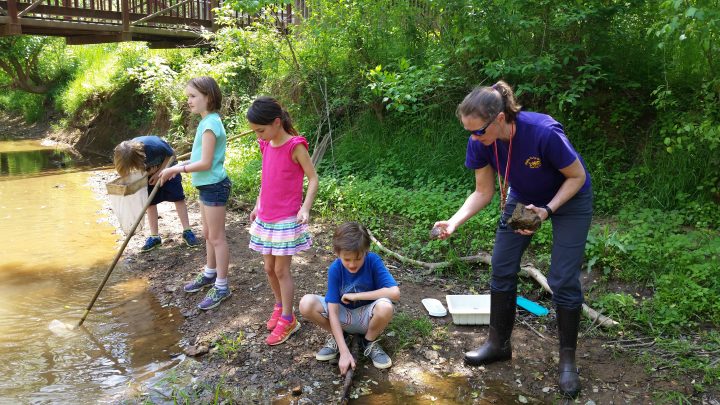
American shad are a schooling fish, and North Carolina is taking that literally. This spring, students across the state are raising and releasing American shad as part of the Shad in the Classroom program.
“Shad in the Classroom allows teachers and students to take part in the actual recovery work being done with American shad,” said Melissa Dowland, coordinator of teacher education at the North Carolina Museum of Natural Sciences. “Every fry that is raised and released by students is contributing to the recovery effort.”
Supporter Spotlight
Participating classrooms receive a delivery of fertilized eggs and spend a week taking care of them until they hatch into baby fish, known as fry.
“During that time, the students are responsible for maintaining their water quality,” said Danielle Pender, Shad in the Classroom program specialist at the North Carolina Museum of Natural Sciences. She explained that students monitor pH and ammonia levels every day.
“They are also watching the shad,” Pender said. “They can see them as the backbone forms, as the eyes form, as the heart starts beating, and as they emerge from the eggs, they also make sure to sort out any eggs that are not viable so that they don’t contaminate the tank.”
At the end of the week, the class takes a field trip to the river to release the fry. Standing along the riverbank, the students dip cups into the water and send the tiny fish off into the wild.
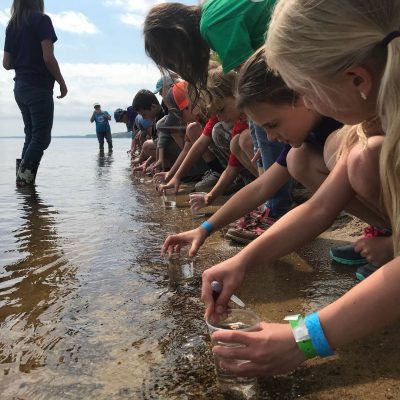
“My students have absolutely loved participating in the program,” said Kelly Riley, executive director of the Tiller School in Beaufort. “Each year they respond to our reflection at the end of the project and the fact that they feel like they are truly scientists is the most rewarding part. They continually say that they feel like they have made a difference in the world and they’ve learned so much about such an amazing organism.”
Supporter Spotlight
Tackling complex ecological issues requires teamwork. In addition to the Museum of Natural Sciences, the many organizations involved in Shad in the Classroom include the Albemarle-Pamlico National Estuary Partnership, or APNEP, the U.S. Fish and Wildlife Service, North Carolina State University, East Carolina University, the North Carolina Wildlife Resources Commission and the state Department of Environmental Quality’s Division of Water Resources.
“APNEP provides a substantial part of the funding that makes Shad in the Classroom possible,” said Kelsey Ellis, APNEP program associate. APNEP staff also support program logistics, such as egg deliveries and online media.
“Initiatives like Shad in the Classroom, which increase public understanding of the connections between the freshwater and saltwater parts of our watershed, are central to APNEP’s integrated approach to identifying, protecting, and restoring the region’s significant resources,” said Bill Crowell, APNEP director.
Shad in the Classroom started in 2009. As of 2017, it had reached 186 classrooms, some of which are in Tier 1 counties, those among the 40 most distressed counties as designated by the state Department of Commerce. The program is currently at capacity with 29 classes for 2018, and organizers hope to find new partnerships to reach even more students in the future.
From River to Sea
So why do the students raise American shad? “To be honest, there’s a conservation need,” said Ben Ricks, the Wildlife Resources Commission’s District 2 fisheries biologist. “While the shad are doing fairly well, they’re not at the same level they were historically, and so we’re doing everything we can to try to bolster their numbers, and stocking is one of the major tools that we (use) for that.”
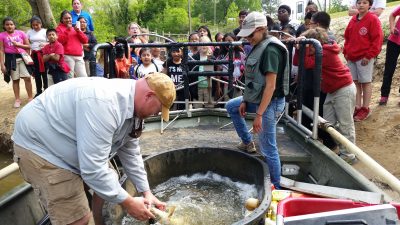
American shad are a type of anadromous fish, meaning they are born in freshwater, grow up in the ocean, and return to freshwater to spawn.
In North Carolina, American shad swim up the Neuse or Roanoke rivers each spring to spawn. The fry stay in the river from six to 12 months, when they migrate to the ocean, traveling as far north as the Bay of Fundy in Canada.
After three to five years, the shad return to the same river in which they were spawned to continue the cycle. About half of the American shad in North Carolina are repeat spawners – they return to the ocean after spawning.
“Shad in the Classroom encapsulates APNEP’s ‘stream-to-sound’ approach,” Crowell said. “Students release young Shad into the region’s rivers, and the fish migrate to the sounds and ocean before returning to those same rivers to spawn as adults.”
The shad owe their impressive sense of direction to their olfactory senses. “Essentially they taste their way back home through chemical responses,” Ricks said. To ensure the fishes’ survival, Shad in the Classroom participants must release fry into the river from which they were collected.
American shad numbers have declined because of habitat degradation and physical barriers to spawning, such as dams. Stocking programs like the one at the Fish and Wildlife Service’s Edenton National Fish Hatchery are attempting to reverse the trend.
Ricks explains that the stocking process begins by placing male and female American shad in large tanks. Hatchery personnel collect the eggs once spawning begins. When the eggs hatch, fry are moved to another tank and released within a week. NCRWC stocks between 500,000 and 1 million American shad fry annually.
“The important thing to note is that Shad in the Classroom is part of the restoration project,” Ricks said. “It’s not just kind of an academic exercise. They’re working with us, they’re part of it.”
That message is especially clear on release day. Students are generally delighted to be outdoors, and for some of them, it’s their first visit to a river. Shad in the Classroom provides all funding for the field trips.
Cross-Curriculum Learning
Graduate students in the Student Fisheries Society, a subunit of the American Fisheries Society at N.C. State, also contribute their expertise to Shad in the Classroom.
Gus Engman, a postdoctoral researcher at N.C. State, leads fish dissections in classrooms.
“We do a little bit of a lecture on fish anatomy usually before the dissection, and then what I normally do is a demonstration dissection,” Engman explained.
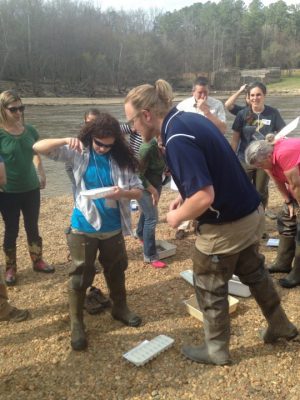
The students work in small groups to dissect hickory shad or other fish collected as bycatch during fieldwork. Some students might be squeamish at first, but they quickly become fascinated.
“Everyone’s like, ‘Eww!’ at the beginning,” said Tiffany Penland, a fisheries manager with the Tennessee Wildlife Resources Agency, who volunteered while completing her master’s degree at N.C. State. “But by the end, these kids – especially the ones going, ‘Eww!’ – are the ones diving in.”
Penland also led a macroinvertebrate identification lesson using critters she had collected from the streambed – “usually crayfish, maybe some damselflies or dragonflies.” Macroinvertebrates are bioindicators of stream health.
“There’s so much going on under the water, and most people have no idea all the different things that are in there, so I love exposing people, especially kids, to all that stuff,” Penland said.
Shad in the Classroom facilitates learning about much more than just fish. “Learning about shad supports curriculum at a variety of levels and covers topics including animal adaptations, water and environmental quality, genetics, food webs and ecosystems, anatomy, and more,” Dowland said.
The program even offers lesson plans that incorporate the arts. As teachers develop new lessons, they can upload them to an online repository.
“There are so many great (lesson plans) that are provided by the program through the North Carolina Museum of Natural Sciences,” said Riley. “The fourth-grade teacher that is doing it this year at Tiller School is using many of the lesson plans as is and has thoroughly enjoyed using those with her students.”
Inspiring the Next Generation
Shad in the Classroom instills an enthusiasm for nature through hands-on engagement.
“One of my favorite things is the reaction we get when we arrive at schools on a Monday in April with shad eggs,” Dowland said. “Teachers have prepared their students with lots of information and excitement about their ‘shad babies,’ and [they] gather outside or in the halls to cheer when the eggs arrive.”
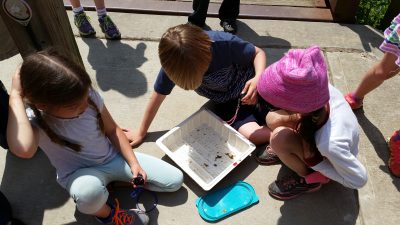
Students develop a close bond with the shad as they care for them. Pender recalled that one classroom sang to the shad during the release. “They will talk about their hopes for what happens to the shad,” she said.
The young students aren’t the only ones who benefit. “My ultimate career goal is to become a professor,” Engman said, “so it’s always great for me to get the opportunity to practice teaching.” He has adapted the dissection for English as a Second Language classrooms.
Above all, Shad in the Classroom empowers students to become stewards of a planet beset by challenges.
“I think there’s a lot of value in the personal connection to shad that students and their teachers gain from participating in the program,” Ellis said. “My hope is that students carry their Shad in the Classroom experience with them, and the values that they derive from it help to shape how they interact with the natural world.”
“To have something that you can see and feel that you are making a difference, I think gives a lot of hope,” Pender said. “You can do something.”
The shad may only be in the classroom a short time, but they impart lessons that linger long after they swim off downstream.








